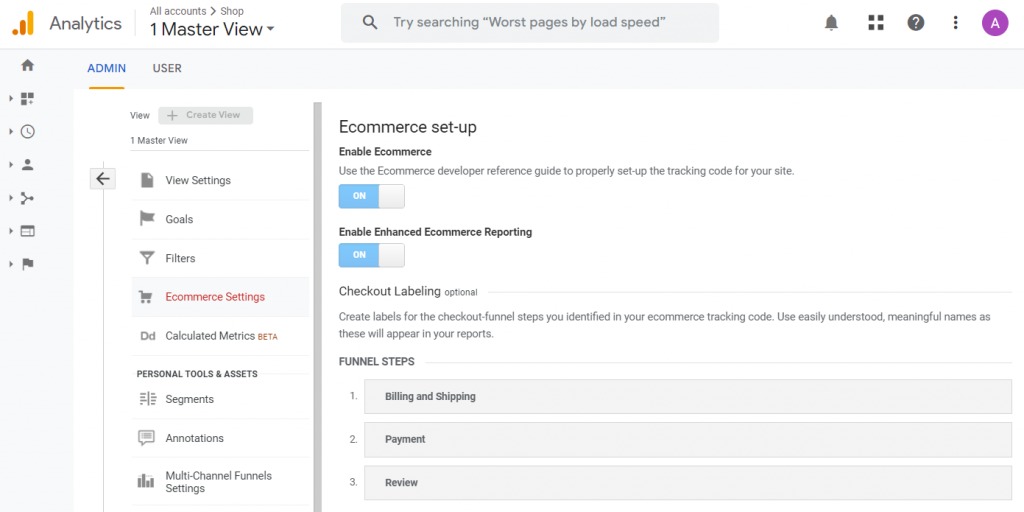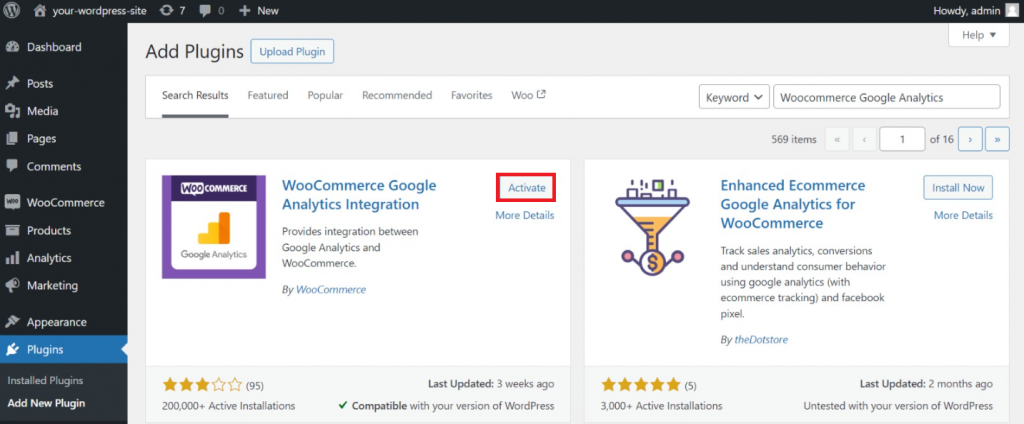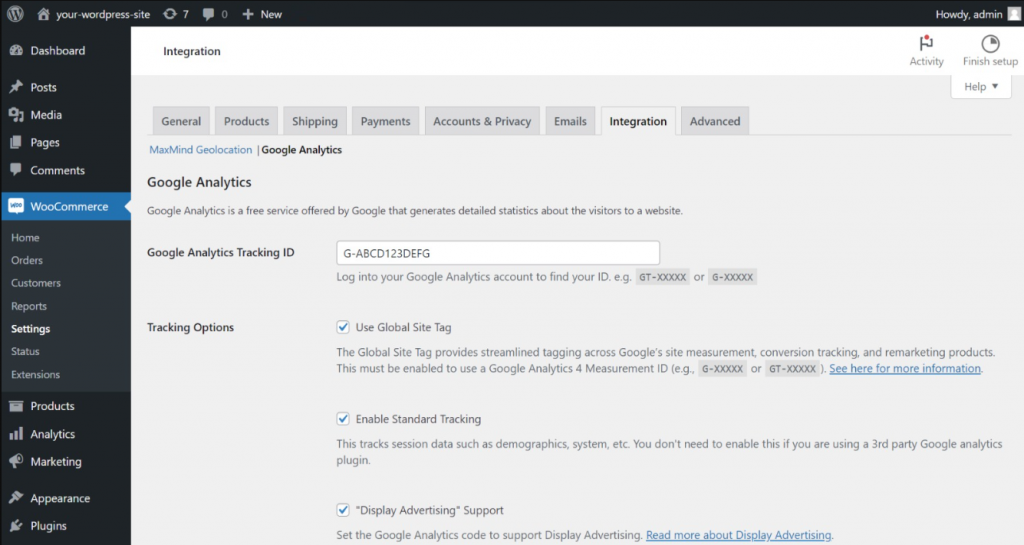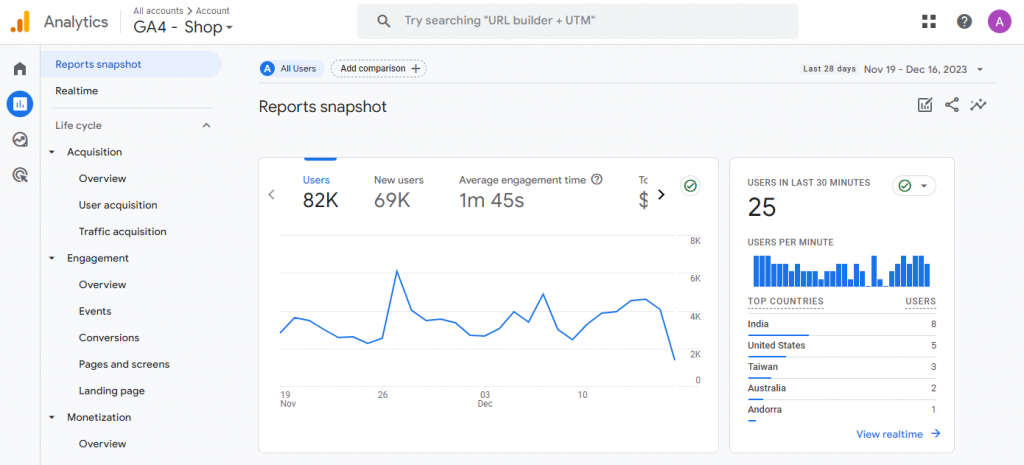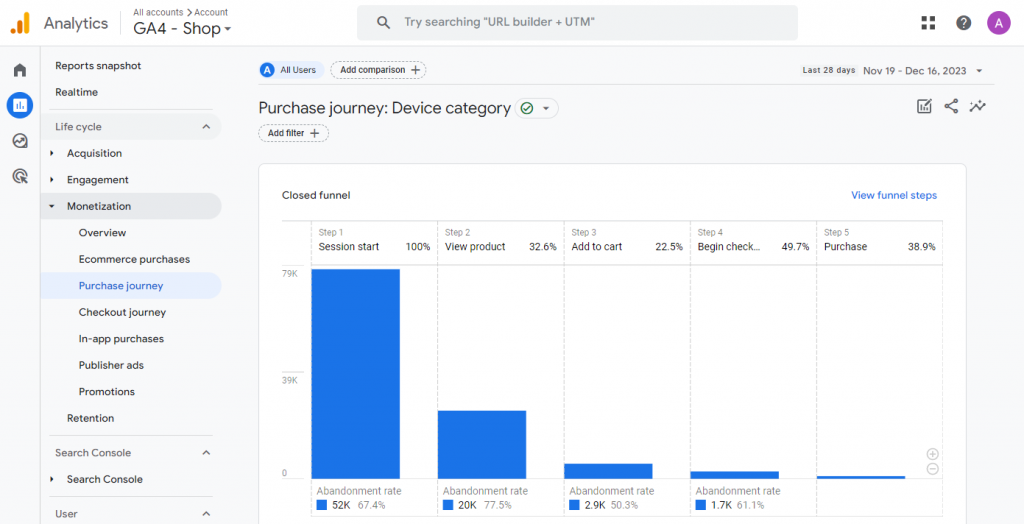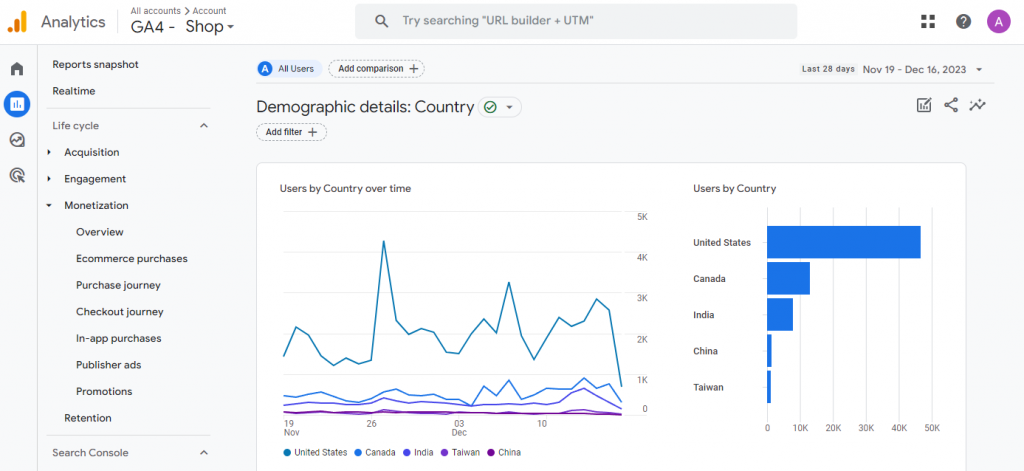How to Set Up WooCommerce Google Analytics Integration Using a Plugin
Online store owners need insights and data about their customer behavior as well as product performance to optimize their eCommerce website.
Luckily, WordPress users can easily get this data by setting up WooCommerce Google Analytics integration. This monitoring tool helps track important metrics, including traffic and conversion rates.
In this WordPress tutorial, we will explain how to set up the integration using a plugin and the benefits of tracking your eCommerce website performance using Google Analytics.
How to Enable Google Analytics on WooCommerce Store
We will use WooCommerce Google Analytics Integration, a free plugin that’s easy to set up.
1. Set Up a Google Analytics Account
To start the integration, you must create a free Google Analytics account and retrieve the tracking ID. Here’s how to do so:
- Go to the Google Analytics website and log into your Google account.
- On the landing page, click Start Measuring.
- Enter your Account name and configure the data sharing settings. Click Next.
- Create a new Property (the website or application Google Analytics will track) by entering the name. Then, select the time zone and currency. Click Next.
- Enter your business industry and size. Click Next.
- Select your business objectives. Click Create to confirm.
- Choose Web as the data stream source for Google Analytics.
- Enter your website URL and copy the Measurement ID. This will be the tracking ID you will use to connect the plugin.
Note that if you already have a Google Analytics account, you just have to log in and navigate to Admin → Create → Account. Follow steps 3-8 above to retrieve the Google Analytics ID.
Creating a new account will set up Google Analytics 4 by default. If you prefer the older version, read the guide on creating a Universal Analytics account.
If you use Universal Analytics, navigate to the sidebar and press the gear icon to open the Admin menu. Under the View category, select Ecommerce Settings. Click the Enable Ecommerce and Enable Enhanced Ecommerce Reporting toggles.
2. Install the Plugin
Once you have your Google Analytics tracking ID, install the plugin on your WordPress websites. Here’s how to do it from your admin dashboard:
- Log in to your Admin dashboard. Navigate to the sidebar → Plugins → Add New Plugin.
- Search WooCommerce Google Analytics Integration and press Enter. Click Install.
- After the installation is complete, click Activate.
Alternatively, install the WordPress plugin manually by downloading it as a ZIP and uploading it to the admin dashboard. Here are the steps:
- Open the official WooCommerce Google Analytics plugin download page. Click Free Download.
- In your WordPress dashboard, navigate to the Add New Plugin menu.
- Click Upload Plugin → Choose File.
- Select the downloaded plugin file and click Install Now.
- Click Activate after the process is finished.
In this tutorial, we use the free version. However, if you need additional features and more comprehensive tracking, you may opt for the $79 Pro plan.
The Pro plugin’s extra functionalities include checkout behavior analysis, user ID tracker, cart metric monitoring, and cancellation checker. Check the Pro vs Free comparison page to learn which suits your needs.
Suggested Reading
Discover other best WooCommerce plugins for various purposes, like improving security and optimizing page load speed.
3. Configure WooCommerce Google Analytics Integration Plugin
To integrate Google Analytics, you must set up the eCommerce site first. If you haven’t, follow the steps in this WooCommerce tutorial.
Hostinger WooCommerce hosting plan users can configure the application easily using our Auto installer feature in hPanel. Alternatively, set up the WooCommerce plugin via your WordPress dashboard.

To connect WooCommerce with the plugin, open your WordPress admin dashboard and navigate to the sidebar → WooCommerce → Settings. Select the Integration tab and click Google Analytics.
Enter your tracking ID and configure the plugin settings, including these tracking options:
- Use Global Site Tag. Enables a Google Tag on your WordPress site to streamline tracking. It is also mandatory for Google Analytics 4.
- Display Advertising Support. Sets up tracking code for your Google Display Network ads.
- Enhanced Link Attribution. Differentiates links to the same URL from a page using element IDs to improve tracking.
- Enable standard tracking. Monitors session data like demographics and devices. It is a must if you don’t use other plugins.
- Anonymize IP addresses. Masks website visitors’ IP addresses. Enable it to comply with laws like the General Data Protection Regulation (GDPR).
- Track 404 Errors. Detects broken pages or dead links for simpler analysis.
- Add to Cart Events. Monitors when customers add products to their carts.
- Purchase Transactions. Lets you track transactions by integrating a payment gateway like PayPal.
If you enable Universal Analytics, check the Enhanced eCommerce box and other settings. Click Save Changes to confirm.
Remember that the configuration and steps will differ for other Google Analytics plugins. Check their manual to ensure you set them up correctly.
4. Test the Integration
After 48 hours, check if Google Analytics has retrieved data from your WooCommerce site. Otherwise, there might be misconfiguration in the plugin or monitoring tool, like a mistyped tracking code ID.
Alternatively, check whether your WordPress site’s Google Tag tracking code works properly. To do so, use the Google Tag Assistant debugger to automatically scan issues for simple troubleshooting.
If Google Analytics works properly, it should display several metrics from your eCommerce website. Here are some of the most important ones and their purposes:
- Conversion rate. The number of visitors taking action on your store relative to the total. It is important to distinguish between high and low-quality traffic.
- Ecommerce Purchases. A breakdown of how often visitors view a product, add it to their carts, and buy it and its total revenue.
- User attributes. Your eCommerce website visitors’ demographics, devices, and classifications based on their actions on your site.
- Shopping journey. A funnel representing the steps users take from starting a session to completing a purchase. It lets you view visitors’ purchase or checkout journeys.
- Retention. The proportion of new and returning website visitors. This information helps you improve your strategies to retain existing visitors and improve satisfaction.
To see these metrics, go to your Google Analytics 4 dashboard → sidebar → Reports. If you can’t find them, use the search feature.
Click a category or Overview if you need to view the overall data. Hover over the metric’s name to show the tooltip explaining its purpose.
Why You Should Connect WooCommerce to Google Analytics
Here are some of the top benefits of connecting your eCommerce website to Google Analytics.
Extracting Better Sales Report
Integrating your eCommerce store with Google Analytics lets you gather comprehensive sales data to identify strengths and areas for improvement. For example, you can check the top-selling products and how much revenue they generate.
Product performance analytics help you make crucial business decisions, like adjusting product assortment to align customers’ preferences or managing inventory to avoid overstocking. You can also track the best-selling products and place them on high-traffic pages to drive purchasing decisions.
Moreover, you can learn how products with different pricing models and profit margins perform based on their sales volume. This helps you determine the right balance between revenue and competitiveness.
Data-Driven Decision Making
User behavior analytics helps you create an objective strategy to improve your online store and product appeal to the target audience.
For example, tracking cart events can offer insights into why visitors don’t complete their purchases. It lets you identify pain points in the user’s shopping journey and make the necessary adjustments.
You can also conduct A/B testing and use the insights for a more comprehensive analysis.
Moreover, analyzing user interactions with products and browsing patterns lets you create a personalized marketing strategy. For instance, recommend an item similar to one the visitor has searched for.
Google Analytics also lets you track these metrics according to your needs using custom eCommerce events. They allow you to measure a specific interaction or occurrence in your store.
Optimizing Strategies for Different Devices and Regions
Google Analytics categorizes your store visitors by demographics and devices. These data help you align your marketing efforts to suit potential customers’ preferences.
The visitor device metric tells you whether your store is consistently usable and offers an optimal shopping experience.
For example, suppose you see that Google Chrome users have the highest engagement and conversion rates while Android browser users have the lowest. It might indicate your customized WooCommerce checkout page doesn’t display or work properly on devices with smaller screens. This insight helps you plan a strategy to optimize mobile usability.
Meanwhile, understanding customers’ countries and regions allows you to create a more efficient targeted marketing strategy. You can add their currency options and set up localized Google Ads to personalize the shopping experience.
Conclusion
Gathering eCommerce site data allows online store owners to understand customer behaviors and product performance. If you have a WooCommerce site, you can use a plugin to set up Google Analytics for performance tracking in four key steps:
- Set Up a Google Analytics Account and get your tracking ID.
- Install an integration plugin from the WordPress dashboard or manually upload it.
- Configure the plugin by entering your tracking ID and adjusting settings.
- Test the integration after 48 hours and check for errors.
With WooCommerce analytics enabled, you can now retrieve comprehensive sales reports and create a data-driven approach. Adopt these data and insights to fine-tune your marketing strategy and boost sales.
WooCommerce Google Analytics FAQ
In this section, we will answer common questions about setting up Google Analytics for WooCommerce.
What Is WooCommerce Google Analytics Integration?
Integrating WooCommerce with Google Analytics means connecting your site with the monitoring tool via API. It lets you gather comprehensive data from your eCommerce site to create a more effective marketing strategy and boost sales.
Do I Need to Connect My WooCommerce Store to Google Analytics?
While not required, integrating WooCommerce with Google Analytics helps you easily discover your site’s strengths and weaknesses. Since it is free and easy to set up, we recommend doing so if you want to improve your marketing strategy and increase sales.
Is There Another Alternative to WooCommerce Google Analytics Plugin?
Yes, you can connect MonsterInsights to integrate Google Analytics with WordPress. However, you need the eCommerce add-on, which costs $199.5/year for the Pro version. You can also enable eCommerce analytics using the Google Tag Manager plugin, but the setup process is more complicated.
All of the tutorial content on this website is subject to Hostinger's rigorous editorial standards and values.

